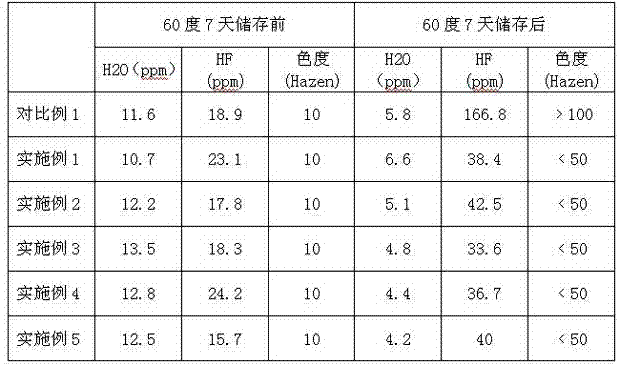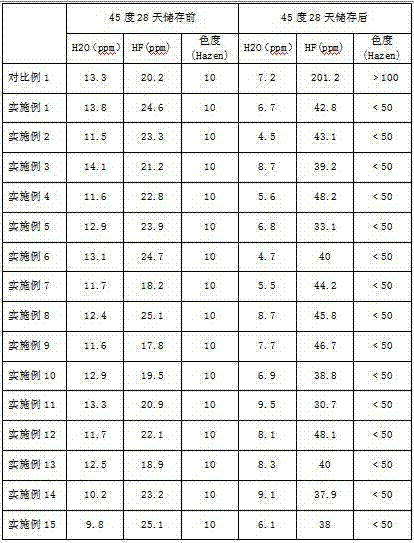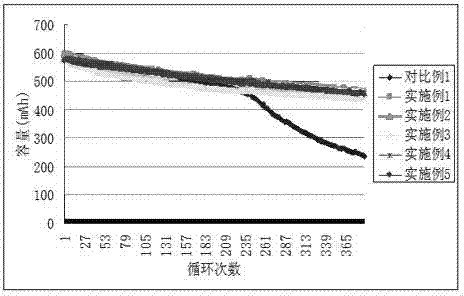A kind of non-aqueous electrolytic solution for lithium secondary battery
A non-aqueous electrolyte, lithium secondary battery technology, applied in secondary batteries, circuits, electrical components, etc., can solve the negative impact of battery subsequent cycle performance and high temperature performance, electrolyte salt solubility reduction, battery discharge efficiency It can improve the charging and discharging efficiency, improve the storage stability and oxidation resistance, and improve the stability.
- Summary
- Abstract
- Description
- Claims
- Application Information
AI Technical Summary
Problems solved by technology
Method used
Image
Examples
Embodiment 1
[0032] LiBF4 and LiPF as lithium salts 6 Soluble in ethylene carbonate (EC) / propylene carbonate (PC) / ethyl methyl carbonate (EMC) / diethyl carbonate (DEC) / ethyl butyrate (EB) (mass ratio 20 / 10 / 10 / 40 Obtain solution in the mixed solvent of / 20), wherein the concentration of LiBF4 is 0.2M, LiPF 6 The concentration is 1M. Then add vinylene carbonate (VC) to the solution by 1% of the total weight of the electrolyte, add ethylene carbonate (VEC) to 0.5% of the total weight of the electrolyte, and add 1% by 5% of the total weight of the electrolyte. 3-propiolactone sulfonate (1,3-PS), add ethanolamine according to 0.1% of the total weight of the electrolyte, add 3-fluorotoluene according to 5% of the total weight of the electrolyte, add 3.9- Bis(octadecyloxy)-2,4,8,10-tetraoxo-3,9-diphosphaspiro[5,5]undecane was used to prepare the electrolyte.
Embodiment 2
[0034] LiBOB and LiPF as lithium salts 6 Soluble in ethylene carbonate (EC) / propylene carbonate (PC) / ethyl methyl carbonate (EMC) / diethyl carbonate (DEC) / ethyl butyrate (EB) (mass ratio 20 / 10 / 10 / 40 / 20) to obtain a solution in a mixed solvent, wherein the concentration of LiBOB is 0.2M, LiPF 6 The concentration is 1M. Then add vinylene carbonate (VC) to the solution by 1% of the total weight of the electrolyte, add ethylene carbonate (VEC) to 0.5% of the total weight of the electrolyte, and add 1% by 5% of the total weight of the electrolyte. 3-propiolactone sulfonate (1,3-PS), add triethylamine according to 0.1% of the total weight of the electrolyte, add 3-fluorobiphenyl according to 5% of the total weight of the electrolyte, add 0.1% of the total weight of the electrolyte Add 2,6-di-tert-butyl-p-cresol (BHT) to prepare the electrolyte.
Embodiment 3
[0036] LiODFB and LiPF as lithium salts 6 Soluble in ethylene carbonate (EC) / propylene carbonate (PC) / ethyl methyl carbonate (EMC) / diethyl carbonate (DEC) / ethyl butyrate (EB) (mass ratio 20 / 10 / 10 / 40 / 20) to obtain a solution in a mixed solvent, wherein the concentration of LiODFB is 0.2M, LiPF 6 The concentration is 1M. Then add vinylene carbonate (VC) to the solution by 1% of the total weight of the electrolyte, add ethylene carbonate (VEC) to 0.5% of the total weight of the electrolyte, and add 1% by 5% of the total weight of the electrolyte. 3-propiolactone sulfonate (1,3-PS), add N,N-dimethylformamide according to 2% of the total weight of the electrolyte, add o-fluorotoluene according to 5% of the total weight of the electrolyte, and add Add 0.1% of the total weight to butylated hydroxyanisole (BHA) to prepare the electrolyte.
PUM
 Login to View More
Login to View More Abstract
Description
Claims
Application Information
 Login to View More
Login to View More - R&D
- Intellectual Property
- Life Sciences
- Materials
- Tech Scout
- Unparalleled Data Quality
- Higher Quality Content
- 60% Fewer Hallucinations
Browse by: Latest US Patents, China's latest patents, Technical Efficacy Thesaurus, Application Domain, Technology Topic, Popular Technical Reports.
© 2025 PatSnap. All rights reserved.Legal|Privacy policy|Modern Slavery Act Transparency Statement|Sitemap|About US| Contact US: help@patsnap.com



